Welcome to Card Game DB
Register now to gain access to all of our features. Once registered and logged in, you will be able to create topics, post replies to existing threads, give reputation to your fellow members, get your own private messenger, post status updates, manage your profile and so much more. If you already have an account, login here - otherwise create an account for free today!
Register now to gain access to all of our features. Once registered and logged in, you will be able to create topics, post replies to existing threads, give reputation to your fellow members, get your own private messenger, post status updates, manage your profile and so much more. If you already have an account, login here - otherwise create an account for free today!
Timing in Call of Cthulhu LCG. Part 1 – Basic Introduction
Aug 20 2013 05:00 AM |
HilariousPete
in Call of Cthulhu
Call of Cthulhu HilariousPete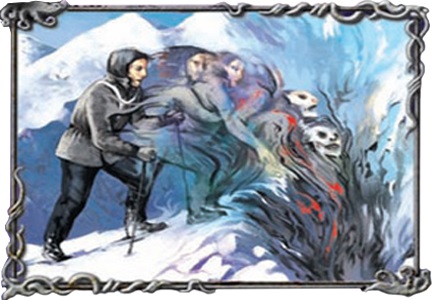 Part 1 – Basic Introduction
Part 1 – Basic IntroductionHello everyone.
As I very much like Call of Cthulhu (CoC) and I’m a person who wants to understand rulings in as detailed a way as possible, I started to think a lot about the timing of CoC. Timing is something that regularly creates confusion among players, regardless of if they’re completely new, experienced or coming from other titles.
I’ve decided to write three articles about timing. This one is a basic introduction into the timing of CoC. It is aimed at beginners to the game. The next article deals with the subtleties of timing that can occur and the target audience are more experienced players. The third article focuses on passive effects and how they resolve in conjunction with the timing of the other triggered effects.
If you play CoC regularly, this article is probably going to be a little remedial for you, but stay tuned for the next one where we delve much deeper into the game's timing mechanisms!
Triggered effects and passive effects
A triggered effect is an effect that has a bold trigger written before it (â€Action:â€, â€Disrupt:â€, â€Response:†and â€Forced Response:â€). For example a card like Shotgun Blast (Core) has a triggered effect. Shadowed Reef (Core) on the other hand, having an absence of a bold trigger word doesn't have a triggered effect. Instead it has a passive effect.
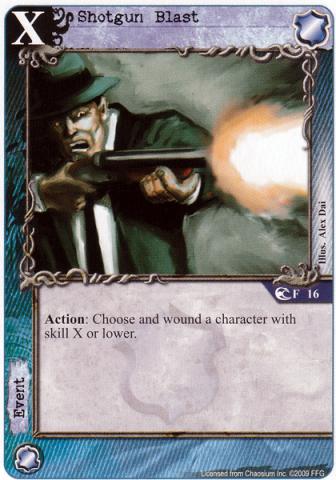
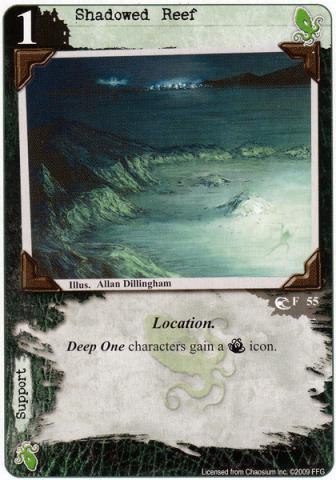
There are several forms of passive effects, I’ll talk about them in more detail during the third article. For beginners it is sufficient to know that there are passives and they have a lasting effect which is “always onâ€, like Shadowed Reef (Core), and that there are passives that have a condition and for the most part behave like “one shot†effects. The middle text in the text box of Khopesh of the Abyss (TSS) features a passive that contains a condition.
Action window timing structure
The first and most important thing to know is that CoC doesn’t use a stack, which is to say a timing resolution system that has a LIFO behavior (last in - first out). Magic the Gathering is the most famous example of a card game that uses the stack mechanism. As many other card games also use the stack most players have some experience with it. In CoC’s case instead of a stack there is a timing structure. It consists of a temporal sequence containing different types of triggered effects and this sequence is predefined. Coming from a LIFO system to the timing structure system can be confusing at first.
Ok, now let’s look at the predefined timing structure itself. In CoC, the sequence of effects for an Action is called an Action window. Actions are the fundamental building blocks of the game, and the Action window timing structure is similarly fundamental to the timing in CoC. The order looks like this:
- Action window starts with the initiation of an Action
- Disrupts
- Resolve Action
- Passive effects
- Forced Responses
- Responses
- Action window closes
- Actions represent basic deeds that can be triggered at will in the game. You must deal with one Action (including all Responses to it) and then after its window is completely finished the next Action can be triggered. In other words: Actions don’t interleave.
Actions are taken alternatively by players. The active player has the first opportunity to take an Action in any given phase and if a player passes, then there is the opportunity for a player to take a second Action in succession.
- Disrupts interfere with another effect that has been initiated but not yet resolved. Usually they cancel or alter the interrupted effect just triggered.
- Responses can be triggered in response to something specific that has just occurred and completely resolved.
- Forced Responses are a special kind of Response. Forced Responses must happen, and are game triggered effects. Actions, Disrupts and Responses are player triggered effects which are always optional.
- Passive effects can be ongoing effects like Shadowed Reef (Core) and don’t fit into the sequence as they are “always onâ€. Passives can also be something more complicated than that, and I will deal with this in another article. Basically passives are not triggered effects, as they lack a bold trigger; and they cannot be canceled.
Assume that Player A has Nikola Tesla (TKatG) in play under his control. He already has 1 success token on him and he is posing a growing danger to Player B. Player B has a Deep One Assault (Core) in his hand and wants to destroy Nikola Tesla (TKatG).
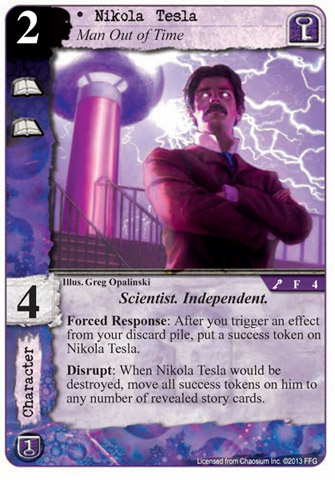
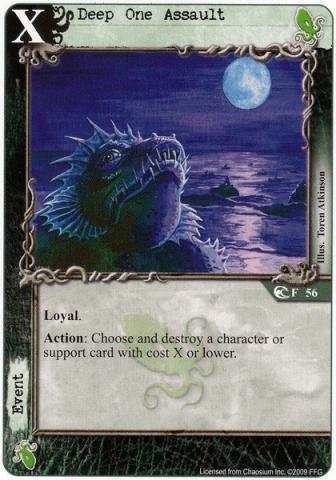
B declares an Action, chooses Nikola Tesla (TKatG) as the target, pays with a domain containing at least 2 Cthulhu resources, because Deep One Assault (Core) (Core) is loyal and plays the card. The Action Window has started and the Action has initiated, but the card text for that Action has not yet resolved:
Action window starts with the initiation of an Action- Disrupts
- Resolve Action
- Passive effects
- Forced Responses
- Responses
- Action window closes
No one wants to play any more Disrupts, and therefore the Action on Deep One Assault (Core) is resolved. Next, Nikola Tesla (TKatG) is destroyed and placed into the discard pile of A.
Action window starts with the initiation of an ActionDisruptsResolve Action- Passive effects
- Forced Responses
- Responses
- Action window closes
Player B is even more prepared for the Deep One Assault (Core) since he also played the prophecy Hanyatl's 1:9 (SoK) onto his draw deck during the last draw phase. In the timing rules of CoC, Responses may trigger off any occurrence that happened during the current Action window. In this case the Action window that had been started by Deep One Assault (Core), so this is still the same Action window. Hanyatl's 1:9 (SoK) triggers because of the Dreamlands Fanatic (ItDoN), which triggered because of the Deep One Assault (Core). Player B accordingly selects and destroys one of A’s support cards.
Note that if B had more than one copy of Dreamlands Fanatic (ItDoN) in hand, he could also trigger other Dreamlands Fanatic (ItDoN) cards, as each Dreamlands Fanatic (ItDoN) can respond to the same occurrence. Each occurrence in the game, like a character being destroyed, can feed any number of consuming effects even on multiple cards. But the occurrence can only be used as a trigger once for each consuming effect.
Action window starts with theinitiation of an ActionDisruptsResolve ActionPassive effectsForced ResponsesResponsesAction window closes
Although the previous example did involve some cards, it wasn’t really complicated. Just by guessing and thinking of the meaning of the word “Disrupt†and so on you probably would have figured out the correct play intuitively. In the majority of your CoC games, you don’t need to look up the timing structure but sometimes there’s a case that’s a bit difficult, and here lies the rub.
Take for example the cards Khopesh of the Abyss (TSS) and Snow Graves (AtMoM):
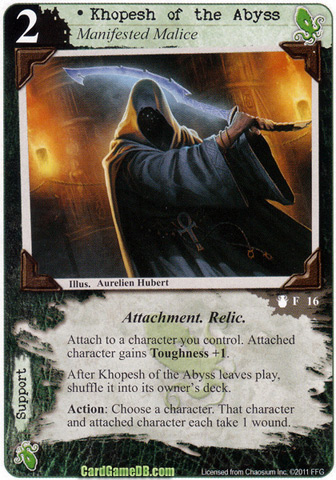
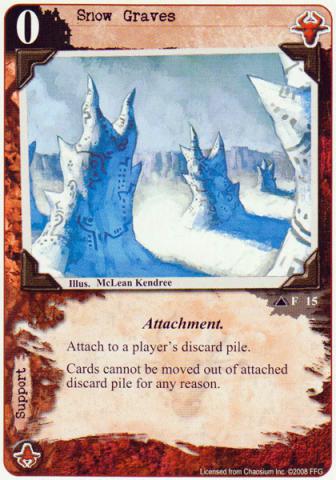
Snow Graves (AtMoM) doesn’t permit the removal of cards from the discard pile, and Khopesh of the Abyss (TSS) has a passive effect on it that shuffles itself back into the draw deck after it entered the discard pile. Now what happens of those two cards are simultaneously in play and your opponent plays Burrowing Beneath (Core) to destroy the Khopesh of the Abyss (TSS) – will Khopesh of the Abyss (TSS) “win†and be shuffled back, or will Snow Graves (AtMoM) “win†and make Khopesh of the Abyss (TSS) stay in the discard pile?
In CoC, the word “cannot†is an absolute. This means that once a card is in the discard pile, there is no way to remove it from there. If an effect would remove a card from the discard pile, the initiation of that effect fails, since a card in the discard pile is an invalid target due to the word “cannotâ€.
To further elaborate on the proper resolution, recall and apply the steps outlined above:
- Action window starts – your opponent chooses Khopesh of the Abyss (TSS) as the target, pays 2 and plays Burrowing Beneath (Core).
- Disrupts – nothing to do here.
- Resolve Action – Burrowing Beneath (Core) puts Khopesh of the Abyss (TSS) in the discard pile.
- Passive effects – Khopesh of the Abyss (TSS) states “after†it leaves play, so its passive would like to initiate and resolve here. But Snow Graves (AtMoM) features a lasting effect that is “always onâ€, so it is also on right now and prevents the effect of Khopesh of the Abyss (TSS) from initiating and resolving.
- Forced Responses
- Responses
- Action Window Closes
Stack vs Action Window
Take a look at these cards here. They are from Middle Earth CCG (MECCG), another beautiful card game that is well worth looking into:



If you read the text of “Wizard’s River Horsesâ€, it is clear that its second option, “cancels an attack†would have been worded as Disrupt in CoC. “The Names Among Them†would have been worded as Response, because it states that it is playable after a scout faced some sort of attack. The Watcher in the Water is a creature, and in MECCG a creature must always start a “chain of effects†(the MECCG equivalent for the stack). This means that no other creature may be played while a creature is in the stack, so creatures are played one after each other and don’t interleave in any way. Their behavior is similar to an Action in CoC.
Now you can see a practical difference between the stack and CoC’s system: you as the player have to read and “parse†the MECCG cards’ texts and rules on your own, whereas the proper slot in the timing structure of CoC can be determined just by looking at the bold trigger.
Partial resolution of effects
Generally you should resolve as much as possible of an effect. Take for example Y'Golonac (Core).
[lightbox='1281902127/med_gallery_38_325961.jpg']1281902127/ffg_gallery_38_325961.jpg[/lightbox]
Its Action can be used to target a character that is already ready, because the text only states “choose 1 characterâ€, not “choose 1 exhausted characterâ€. The effect does two things: The first part readies the character. If a character has been ready from the beginning, this part fails yet the effect continues. The second part of the effect makes the chosen character commit to the same story as Y'Golonac (Core) itself. This part is resolved even if the first part failed. Therefore you can use the Action of Y'Golonac (Core) to force a ready character of your opponent to commit to the same story where Y'Golonac (Core) is committed.
In contrast to that there is the special word “Thenâ€. This is like “cannot†and has its own meaning in CoC. If two effects are separated by the word “Thenâ€, the second part of the effect will only be resolved if the first part has successfully resolved. Example: Small Price to Pay (Core). The first part is to choose two characters and drive one of them insane. The second part is to wound the other character. If you choose your own character to go insane but trigger the Disrupt on The Doorway (TBJ) to return that character to your hand before going insane, you may not wound the opponent character: Card effects refer to cards in play if nothing specific is mentioned. Driving the character insane fails because the character has left play, and therefore the precondition for the second part of Small Price to Pay (Core)'s effect failed. In a way "Then" can be considered a response inside an effect upon the card, linking two parts of the effect.
Also note that you may only trigger an effect if there is at least one valid target. For example if there is no Yithian in play, you are not allowed to play Interstellar Migration (TkatG) and say “Oh, there’s no Yithian so this part fails and I put the event into the discard pile. And then I trigger its second Actionâ€. You need legal targets to start any given effect before the effect resolution can begin. So if there is no valid target, then the effect itself never starts and thus never gets to the “then†stage during the resolution.
Ok, you should be familiar with the basic concept of triggered effects in CoC. I hope you enjoyed the article. Go play some games, and stay tuned for the next article!
- Toqtamish, Danigral, HappyDD and 18 others like this



 Sign In
Sign In Create Account
Create Account











24 Comments
Are you sure about Y'Golonac being able to target a ready character? That's one thing I've been ambiguous on - after all, it doesn't say "Pay 1 to choose a character. Ready that character." It says "Pay 1 to choose and ready a character". From what I've understood formulations like this, you have to be able to do all parts of the sentence to be able to do any of it. So, in this particular instance, you have to be able to:
- Pay 1
- Choose a character
- Ready that character
If he's already ready, he can't be readied, and so as a result you can neither choose him, nor pay resources (which you could conceivably want to do to trigger Cathouse or something)
Is there something I'm missing here?
No. I think it is explained pretty well in that section.. basically choose and ready are not joined with a conditional. Meaning that the entire sentence dose not need to occur.
If it he worked how you say the choose clause would simply be removed and it would be "pay 1 to ready a character. That character must ... etc"
Now if the character doesn't ready the entire effect fails.
Additional points for the MECCG reference. Love that game!
A little confused about the "then" on Small price to pay, together with
Charles Dexter Ward (KD) . If I select my CDW, the insanity is replaced and I can select any other character that can go insane right? Does the wound of small price to pay still trigger?
@Kwakkie: Good question. "Then" can be very complicated sometimes. My second article will also deal with this word again...
Charles Dexter Ward has a replacement effect which completely replaces the end result of making CDW insane with making another character insane. You can argue both sides now: That going insane has still occurred so the cost has been paid, or that the target had been changed so the cost had not been paid. I'd favor the latter option but I'm pretty unsure. I'll send the question to FFG and include the answer via an example in the next article
@PeekaySK: I can see that "and" can be confusing here. "Choose" is another special word in CoC and referes to the selection of the target which happens in the initiation of the Action. The effect itself is to ready the character (plus the second sentence) and it is resolved two steps later in the resolution step of the Action window. Therefore, choosing and readying are separated logically. I suppose the "and" between them has been introduced to smoothen reading the card text, nothing more.
(In case you're still not convinced, I can quote the FAQ
There are no moribund rules in CoC, they are not needed.
Regarding the comparison with AGoT: One other difference is that in CoC there is no separate 'dead' pile. Also, if a unique character leaves play for any reason (including being destroyed or sacrificed), another copy of that character can enter play without problems.
Which reminds me, I really want to play a game or two of CoC now. Anyone play with starter decks on OCTGN?
I'm working on it, but am pretty busy lately. If things go well, it'll be up in 1 week
Thanks a lot for this.
but: Is there an official confirmation by now?
To me the condition would be fullfilled. (I'm playing this combo, too)
Small Price to Pay (Core) just requires to choose a character to go insane. It's okay to choose Charles Dexter Ward (KD). Why not? He is a target for this point. He hasn't Willpower, nor a T icon that would make him an invalid target.
Sptp doesn't require that the chosen character really has to go insane before the other one is wounded.
It's just the condition for wounding the 2nd character, that first the other one was chosen to go insane.
Just IMHO. I would be thankful if it could be clerified.
Thanks.
no, it's not possible. CDW may be targeted by Small Price to Pay, but the wounding won't happen. Here's the response from Damon Stone:
My questions have been:
Actually that's 2 questions and 1 answer, but the reasoning of Damon's answer makes it clear that "no" is the answer to both questions. (I asked the 2nd question in case of the 1st question being answered with "yes".)
About publishing the next article: I won't be able to do it this week, perhaps the next week...
Unfortunately a nice idea that doesn't work...
I have a question. For me to use the event Casting of the skin it says I need to choose a character that is comitted to the story but what I don't understand is can I use this event any time during the story phase or do I need to use it as soon as the character I want to target gets comitted?